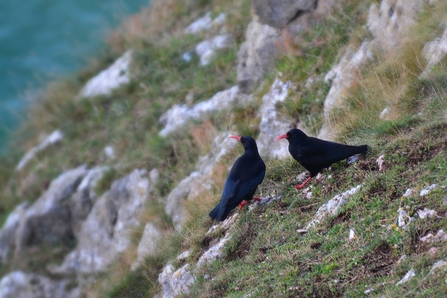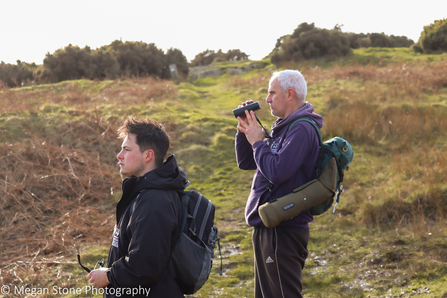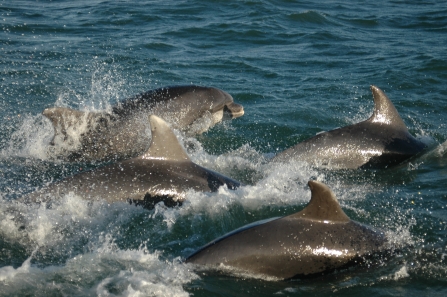With glossy black plumage and those dazzling red legs and bill the chough is the circus acrobat of the bird world, often seen swooping and diving amongst our coastal cliffs, and feeding on short farming pasture. Being the rarest bird of the crow family and with Anglesey holding around 10% of the UK breeding population (Wales holds 78%, 2014) it is of fundamental importance to monitor this population with our changing climate.
Pretty choughed with Anglesey’s choughs!
Choughs at Rhiwledyn © Henry Cook

Choughs at Rhiwledyn © Henry Cook
I joined People & Wildlife Officer Ben Stammers, and Youth Engagement Officer Andy O’Callaghan on the chough survey from Point Lynas to Dulas as part of the RSPB Chough Count on Anglesey. In preparation for the Chough Ccount, Anglesey was split into 41 different sections, and we were one of many chough-spotters with the collective aim of counting chough on the island. We scoured the coastline and grazed patches for any signs of chough present. We listened for their distinctive chee-ow call, reminded ourselves of their large square-like wings and square tail, and Ben mentioned their ability to probe the soil with their down-curved bill to look for invertebrates, and this often leaves behind a mark on the ground from probing, an indication that they are in the area!

© Megan Stone Photography
Although we didn’t see any chough during our survey, this is still vital data for the RSPB so that they can analyse annual Chough Count change through time and distributions across Anglesey. So, you may be wondering – what was the outcome of the Anglesey Chough Count this year, and how does this compare to previous annual counts? Mandy Forde, Volunteer Co-ordinator for RSPB Anglesey Chough Count, passed on the results to me!
I’m sure you will all be choughed to hear (sorry, I couldn’t help it!) that the number of chough spotted on Count Day has increased by 44% since 2020 (unable to carry out a chough count in 2021 due to Covid-19 lockdown rules)! This is the highest chough count for 22 years! The highest counts this year came from Alaw Estuary to Porth Swtan, Porth y Gwyddel to North Stack, and Valley Wetlands, with RSPB Valley Wetlands proving the most popular for the birds on Count Day (24 chough spotted here, 30% of the Anglesey Chough Count). This just goes to show how important reserves are across the UK for birds! Due to the bad weather however, this year’s annual Chough Count was conducted between Friday 11th February and Friday 25th February, which meant that this count wasn’t as representative as previous annual counts; usually the Chough Count is held on one day. Nevertheless, the data collected still provides reasonable up-to-date information on Anglesey’s choughs and Mandy and Ian Sims (North Wales Wetlands Warden), both mentioned that they only identified “10 potential duplicates at most”! They also noted that this year has added to “an encouraging recent trend - … we have not been below 50 (individuals) for 5 years now”!! So, even if there were those duplicates, we would still have a total of 69 chough – which still falls within this trend (79 individuals spotted this year).

Chough © Mike Snelle
Our fortunes of seeing no chough within our area quite literally flipped around when we witnessed the most spectacular gathering of a bottlenose dolphin pod! I’ve seen bottlenose dolphins before… but not on this scale, with an estimated 45 individuals! There were breachers, tail-slappers, Olympic-divers and sprinters within the pod. But my favourite individual has got to be the young calf, which stuck closely to its mother as the pod turned their direction towards Point Lynas. We can assume that they were heading there to feed, as the upwellings here provide a plentiful source of fish and possibly squid and crustaceans too! One of the most surreal moments for me was hearing their bodies hit the water at force as they breached. It’s special moments like this one that reinforces my deep connection with wildlife! I reported our sighting to the SeaWatch Foundation, a national marine environmental charity aiming to protect our cetaceans.

Bottlenose Dolphin Bow Riding_Nia Haf Jones
We also encountered red squirrels, a red kite, buzzards, a peregrine falcon, Jack snipe and snipe, little egret, oyster catchers, a wren, red-necked partridge, a rabbit, starlings, a shag, fulmars, and a great black-backed gull. We were reminded just how special Anglesey is in providing a haven for wildlife. I also recently learned the importance of recording wildlife sightings using Cofnod; the environmental record centre for North Wales, where species records can be used as evidence to highlight the significance of a site to certain species, which could in some cases, enhance the protection of the site. I would highly recommend using Cofnod if you’re in North Wales and spot any wildlife!
The Anglesey Chough Count has been running for an outstanding 32 years, and this monumental achievement could not be done without the help of our ringers, chough enthusiasts and chough-spotters!
This blog was put together by youth forum member Megan Stone, a keen photographer and nature enthusiast.
Head over to Megans' Instagram for even more wild content





